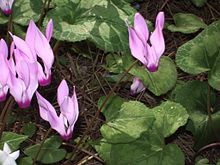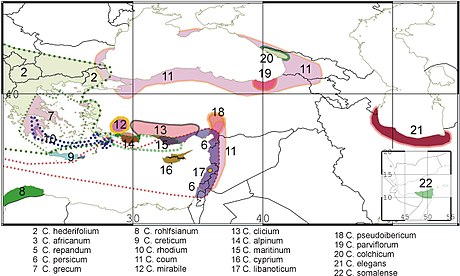Room cyclamen
| Room cyclamen | ||||||||||||
|---|---|---|---|---|---|---|---|---|---|---|---|---|

Room cyclamen ( Cyclamen persicum , cultivated form) |
||||||||||||
| Systematics | ||||||||||||
|
||||||||||||
| Scientific name | ||||||||||||
| Cyclamen persicum | ||||||||||||
| Mill. |
The Cyclamen ( Cyclamen persicum ), including Persian Cyclamen called, is a species of the genus Cyclamen ( Cyclamen ) within the family of Primrose (Primulaceae). It does not occur wild in the Alps, as the German genus cyclamen could suggest, nor in Persia, as the erroneously assigned specific epithet persicum suggests, but in the eastern Mediterranean.
Cyclamen persicum is a very popular, economically important houseplant. Variety breeding began in Western Europe from around 1860. It is currently offered as a houseplant in a wide range of varieties. The different varieties of the indoor cyclamen are based exclusively on breeds with different origins of the wild species. No other species of cyclamen were crossed.
description
The indoor cyclamen grows as a perennial , herbaceous plant that can reach heights of up to 32 centimeters. As a storage and persistence organ, it forms a persistent hypocotyl bulb . It arises solely from a thickening of the hypocotyl , the area of the stem axis between the root neck and the first cotyledon. The rounded, somewhat flattened tuber with age is about 4 to 15 centimeters or more than 15 centimeters in diameter. It has a corky consistency. The roots arise from the underside and the long-stalked leaves of the plant, arranged in a spiral, arise from the upper side . The length and width of the heart-shaped leaf blade varies between 3 and 14 centimeters. It is fleshy and smoothly structured. The leaf margin is somewhat thickened and usually serrated. It rarely forms edges or lobes. The upper side of the leaf often has a green-silvery marbled color scheme, the underside of the leaf can be pale-green or reddish in color. They feed their leaves in the dry and / or cool season. If the growing conditions are favorable again, they sprout again and bloom. You should also allow the plants to do this in rooms with indoor cyclamen and let them move in after the flowering period and then push them back on after a period of rest. You thank it with a lush blossom.
Cyclamen have flowers standing on individual stems that hang down, but whose petals are strongly curved upwards. The color of the flowers ranges from white to pink to purple.
The fruits are capsules that, as they ripen, are sunk into the ground by growing and curving the stem. The capsules only open when they are in the ground.
The number of chromosomes is 2n = 48, in some cultures also 2n = 72, 96 and 136.
Origin of names and taxonomy

Cyclamen persicum was first described by Phillip Miller in 1768 . There are two different explanations for the botanical epithet persicum :
- It refers to the - erroneous - assumption that the plant comes from Persia. This assumption, which was also expressed in the first description, can already be found in a garden book published in 1659.
- It refers to the peach red color ( Prunus persica ) of the flowers. This assumption has its origin in a book published in 1629 in which the flowers of Cyclamen persicum are described as peach-colored.
There are different forms and varieties:
- Cyclamen persicum var. Autumnale Gray-Wilson flowers in autumn (instead of March-April)
- Cyclamen persicum f. albidum (Jord.) Gray-Wilson has pure white flowers
- Cyclamen persicum f. roseum has pink-red flowers without a purple-red spot at the entrance to the throat
- Cyclamen persicum f. puniceum (Glasau) Gray-Wilson has evenly red to carmine-red flowers
Occurrence
The natural range of Cyclamen persicum extends from North Africa across West Asia to Southeast Europe. The following occurrences are documented in detail: In North Africa the species is represented in the northern and eastern parts of Algeria as well as in northern Tunisia. In western Asia, stocks have been confirmed in Cyprus, Israel, Jordan, western Syria, and western Turkey. The only occurrences in Europe were found in the eastern part of Greece. The preferred habitats include pine forests, oak bushes and open rocky slopes, mostly on calcareous soils up to an altitude of 1000 meters. During the vegetation phase in the winter half-year, average light and average temperatures are typical for the home location. In the summer half year it is very hot (40 to 45 ° C) and dry. The high temperature and the drought lead to the death of the above-ground parts of the plant. The plants survive the dry period in their flat underground tubers. They then sprout again at the beginning of the colder season.
The exact original distribution is not known. The occurrence on some Greek islands and in North Africa is likely to go back to the historical use for cemetery and monastery planting, presumably the same applies to some of the Turkish occurrences.
use
history
This species probably came to Paris before it was first mentioned in 1620. It has certainly been cultivated in France since 1731. The start of variety breeding is dated to the year 1860. Starting from England, which played a pioneering role here, breeding of the varieties of Cyclamen persicum began shortly afterwards in the Netherlands and Germany .
The different varieties of the indoor cyclamen were created exclusively through breeding with variants of the wild species. There was no crossing of other species.
Requirements for culture worthiness
In nature, the species shows a certain variability in flowering time and color.
- Fast-growing: In contrast to other cyclamen, instant germs when freshly sown or warm pre-soaking. Also in contrast to other cyclamen, blooms after a few months.
- Roots at the bottom of the tuber - can be cultivated in a pot that is much too shallow, with the tuber looking out of the substrate. Due to the susceptibility to fungi and microorganisms in moisture, the cultivation of deeply placed tubers in pots is only possible for experienced gardeners.
Culture
Cyclamen are available almost all year round, but the main season in Central Europe is between September and March.
The seeds are produced in special companies. A large part of the modern varieties are F1 hybrids, i.e. varieties with a heterosis effect that cannot be propagated through seeds.
Cyclamen are propagated by seeds. The seeds should be very fresh, seeds do not have a long shelf life. Cyclamen are dark germs , so the seeds are covered with soil and placed in a dark place. The best germination temperature is 18 ° C. The germination period is 20 to 30 days. After germination, the seed boxes are placed in the light.
It is pricked and a few weeks later potted in the final pot. Further cultivation takes place at around 18 to 21 ° C. The cooler it is cultivated, the more compact and willing to flower the plants become. Cyclamen persicum belong to the day- neutral plants . The flowers are created from the appearance of the seventh leaf. There are 14 to 22 pots per m² in the end spacing. The cultivation period is approx. 8 months for spring sowing and approx. 11 months for summer sowing.
With good cultivation, the plants can be around 20 to 30 years old.
sorts
Indoor cyclamen ( Cyclamen persicum ) have been raised for several hundred years and have been cultivated in breeding since the 19th century. One variety that has long been very important is 'Beacon'. In addition to the large varieties, there is also an assortment of small varieties. Some, especially large-flowered varieties, have lost their typical fragrance in the course of breeding history. Hybrids with other species have not been obtained naturally. The only sufficiently close relative belonging to the same subgenus would be the Somalia cyclamen ( Cyclamen somalense ), which is not cultivated. Through tissue culture of the fresh zygotes (micro-propagation) a hybrid with the Central European summer cyclamen ( Cyclamen purpurascens ) could be achieved, which is traded as the hardy variety 'Odorella'. This sterile strain is very short lived and obsolete. It can only be propagated through tissue culture and kept alive for a longer period of time.
Variety groups
The variety groups each have varieties with a color spectrum from the typical cyclamen red to violet, pink tones and white, and two-tone flowers are also common. There are true seed varieties and F1 hybrids .
- 'Butterfly'
- 'Halios'
- 'Laser'
- 'Latinia'
- Normal cyclamen breed Beck
- 'Sierra'
- 'Zehlendorf'
- Miniature cyclamen Schoneveld Super series Compacta
- Miniature breed Beck
supporting documents
- ↑ Armin Jagel, Marcus Lubienski: Cyclamen persicum - room cyclamen (Primulaceae) and other cyclamen in the garden. Yearbook of the Bochum Botanical Association. Vol. 9, 2018, pp. 195–206 ( PDF 7 MB)
- ↑ a b c d Christopher Gray-Wilson: Cyclamen: a guide for gardeners, horticulturists and botanists. BT Batsford, London 2002, ISBN 0-7134-8760-7 .
- ↑ Ulm University: Morphology of the Axis , accessed on March 13, 2012.
- ^ A b c Michael Hickey, Clive King: Common families of flowering plants , the press syndicate of the University of Cambridge 2003, pp. 72 f. ISBN 0-521 57281-9
- ↑ a b c d Eckehart J. Jäger, Friedrich Ebel, Peter Hanelt, Gerd K. Müller (eds.): Exkursionsflora von Deutschland . Founded by Werner Rothmaler. tape 5 : Herbaceous ornamental and useful plants . Springer, Spektrum Akademischer Verlag, Berlin / Heidelberg 2008, ISBN 978-3-8274-0918-8 , pp. 282-283 .
- ^ Philip Miller: The Gardeners Dictionary. 8th edition. John and Francis Rivington et al., London 1768, S. CYC-CYC, online.
- ↑ Cyclamen persicum Mill ., Accessed February 25, 2012 in the United States Department of Agriculture Agricultural Research Service, Beltsville Area Germplasm Resources Information Network (GRIN)
- ↑ Cyclamen persicum Distribution & Habitat ( Memento of the original from March 28, 2010 in the Internet Archive ) Info: The archive link was inserted automatically and has not yet been checked. Please check the original and archive link according to the instructions and then remove this notice.
- ↑ Botanical Garden of Johannes Gutenberg University in Mainz: Alpenveilchen-Cyclamen persicum Mill , accessed on April 8, 2012











